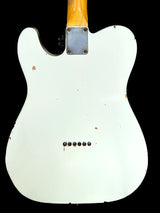Author: Santiago Motto
Your guitar tone is the result of a combination of factors. These include wood, strings, effect pedals, amplifiers, and, of course, your guitar pickups. But, in a market so overcrowded with models, how can we choose the perfect pickup for our guitar? Moreover, is there such a thing as “the right pickup” for my guitar sound?
If these questions linger in your mind when you go to bed and names like Seymour Duncan, Dimarzio, EMG, and Fishman visit you in your dreams, you’re in the right place.
Read on because all answers are just a few paragraphs away.
The Rule of Thumb
As a rule of thumb, we can say that your pickups need to match your equipment in a way they can make it sound like you need it to. Therefore, try removing gain stages, moving knobs, and plugging friends’ guitars until you find the tone you’ve always dreamed of. Then, get a guitar pickup that can match the selection that gave you that tone.
First Off: What Are You Trying to Achieve?
The first thing we need to address before diving right into guitar pickups is why you want to change your guitar’s pickups. Is it a tonal thing, a gain thing, or a combination of both? What happens with this accessory (an integral part of your tone, btw) is that making a guitar pickup comparison is almost impossible.
Well, although it’s true you can try guitars with different pickups, they never sound the same because wood, strings, and other factors also affect the tone. Therefore, we’ll start this journey with a little exercise that involves your guitar pickup selector and knobs.
Please, follow these simple steps:
- Play your guitar in every position of the pickup selector; let’s say, 5 minutes in each position.
- Use your guitar controls to tweak the tone to your preference.
- Write down what you like and what you don’t like about your tone.
That piece of paper with your preferences will be the lighthouse that will direct your search in a vast ocean of information.
Do you have it? Great, it’s time to move on.
Let’s Talk Playing Styles & Genres
Now that you know what you’re trying to achieve, it is time to decide what genre your preferences suit the best. This will define much of what comes up next.

For example, if you’re a player who likes playing with dynamics and getting more response from your guitar as you dig in and a quieter, softer tone as you play gentler, then your first enemy is compression. Therefore, you should aim for a vintage, natural sound that can come from Alnico II, Alnico III, and even Alnico V single-coil pickups, P-90 pickups, or vintage-style PAF-voiced humbucker pickups.
On the other hand, when looking for a more aggressive tone that can drive an amp easier and generate more distortion, you need a high-gain humbucker pickup that can be active like the EMG 81 and 85 or Fishman Fluence or passive like Seymour Duncan’s Trembucker or the Dimarzio Tone Zone or Super Distortion.
Write down your preference in the same paper as you did before.
Getting Inspiration from Personal Heroes
If you find yourself a little lost in what the best pickups for rock or best guitar pickups for blues are, worry not, just look at your heroes for inspiration; what do they use in their guitars? This will give you a good idea regarding brands, models, and types.
Let’s Talk Tone Preferences
Now, if you’ve been playing your guitar for some time and want to address a specific aspect of its sound that you think is lacking or not suitable for your playing, you should focus on tone.
Furthermore, sometimes, and this happens to all of us, our musical and playing taste changes with time. Therefore, if you used to swear by humbucker pickups it is normal that you gravitate more toward P-90 pickups or Ceramic single-coils.
Here, we’ll see how to change your tone without buying another guitar.
Brightness
Some guitars are brighter than others. For example, if you have a guitar with an ash body and a maple neck, it will naturally sound brighter than a guitar with a mahogany body and neck and a rosewood fingerboard.
Brightness isn’t necessarily a bad thing. For example, Eric Clapton started his career with a huge, dark tone, and if you ever picked up his signature guitar, you’ll realize he’s on the opposite side of the tonal spectrum.
So, in this stage it is important to note: do you want more brightness or less brightness in your current tone?
- Darker sounds come from humbuckers.
- P-90 pickups focus more on the midrange.
- Single-coil pickups tend to sound more treble-oriented.

Gain
The new guitar pickup technology invented in the past decades has taken gain to obnoxious levels. Indeed, the Sustainiac Pickup, the Fishman Fluence line, and EMG pickups create a bigger magnetic pull by adding an active system powered by a 9v battery (or two if your name is Zakk and you’re wild).
So, if your paper says you want your guitar to have more gain and you’re playing a single-coil guitar, then you can consider getting a single-coil size humbucker like the Little ’59 by Seymour Duncan or the Hot Rails by Dimarzio.
Moreover, if you’re currently playing a humbucker-equipped guitar, perhaps you can try with an active set or go for a pickup with lots of gain like a Dimarzio Super Distortion or a DB Lollar Pickup.
On the other hand, to reduce gain, you can always opt for a vintage-sounding humbucker close to the vintage PAFs, or a humbucker-sized P-90 for a humbucker-style guitar. The Seymour Duncan Antiquity line is great for vintage tones.
If you play single coils, you can try the Antiquity line too and move toward Alnico 2 and 3 and stay away from Ceramic and Alnico 8 magnets.
What Are You Plugging Your Guitar Into?
As we said before, your tone is the result of a combination of factors. In this combination, the equipment we use (amps, pedals) is paramount to the resulting sound. So, following what we have written down in our paper so far, we need to understand how to match guitar pickups with amps and effects.
The Neverending Story of the Guitar Pickups & Distortion
Distortion is a wild animal that’s hard to tame. Some guitar players tend to stack layers upon layers of high-gain devices in the search for the heaviest tone on Earth. Well, this is not necessarily the best approach because a very hot pedal or amp with a hot humbucker can give us a muddy tone. A great example of this is Mr. Gary Clark Jr. mixing P-90s and fuzz for a clear, heavily distorted tone.
So, my suggestion is to try adding gain stages one at a time, and if necessary, use quieter pickups.
Compressors, Clean Tones & Guitar Pickups
Beautiful clean tones don’t necessarily have to come from low-gain single coils and solid-state amps.
This is a common mistake we’ve all made. If you’re after a cleaner tone, try a moderate-output humbucker and roll back your volume knob. This will give you a fuller, rounder tone with enough gain to cut through the mix keeping the amp crystal-clear with zero overdrive.

Let’s Talk Budget
Before moving on to another major aspect of guitar-pickup choosing, it is important to address the elephant in the room: budget.
As you might have already seen, not every brand charges the same for the pickups they make. This is not only based on technology or component quality, but it is also deeply related to the hours of R&D they invested in the creation of every model.
Some brands like Lollar, Seymour Duncan, EMG, Fishman, Dimarzio, Rio Grande, Lindy Fralin, Lace Sensor Pickups, Fender, and Gibson are considered top-notch brands, and their prices match that reputation.
If your budget doesn’t allow their products, you have other more affordable brands like, for example, Wilkinson. Bear in mind that these more affordable brands are very likely the ones that made the OEM pickups your guitar already has, so the difference if any, won’t be so noticeable.
In summary, set a maximum budget for this endeavor, and don’t forget to include the technician’s fee in it because going DIY with it can be a recipe for disaster.
Let’s Talk Guitar Quality
Finally, this is a myth that has been around for as long as replacement pickups: “we shouldn’t change the pickups in high-quality guitars.” This is not only a myth but also a big mistake that can take you to sell a guitar that plays great, looks cool, and stays in tune.
In this mindset, if you play, for example, a PRS Modern Eagle, a Tom Anderson, a Suhr, a Pensa, a Fender or Gibson Custom Shop, or a Knaggs guitar the pickups match the guitar perfectly because thousands of dollars and hundreds of hours of R&D say so. Well, think again, because aftermarket guitar pickups can make the guitar tone more of your liking, or more useful for your projects.
Therefore, even if Paul Reed Smith comes up with the most amazing pickups for his guitars, they might not be the best for you. This doesn’t mean you shouldn’t play one of his marvelous instruments that excel in every other category.
To sum it up, let’s say it this way: changing your guitar pickups is the cheapest tone experiment instrument-wise. Don’t hesitate to do it; you can always reinstall the original ones at any time.
A great example of this is John Frusciante’s original ’62 and ’54 Stratocasters loaded with Seymour Duncan SSL-1 pickups ($79). Would you modify an original ’54 or ’62? Neither would I, but the tone is always king (and John knows it).
Do Expensive Pickups Make a Real Difference in an Average Guitar?
We addressed the “original pickups in expensive guitars are sacred” myth. The line “expensive guitar pickups make any guitar sound amazing” is another myth.
Indeed, if you buy a Squier Stratocaster and install Seymour Duncan SSL-1s on it, your guitar won’t sound like John Frusciante’s guitar. This is because, as we said at the beginning, your tone is a combination, a summation of factors. That being said, if John is your hero, installing those pickups might get you closer to his sound (minding the gap, of course).
Finally, there are two important things to note about this:
- High-gain pickups, especially those with an active preamp can modify your guitar tone the most. Installing this type of pickup will enhance your tone, but will also amplify any of its flaws.
- Changing guitar pickups is the cheapest, most impactful tone experiment you can perform. Therefore, if your budget allows it, try it. Just don’t expect that installing a pair of PRS 57/08 pickups in PRS SE will make it sound equally good as the real thing.
Conclusion
By now, your piece of paper will have detailed information narrowing down the zillion options available in the market to a handful, or even better, one or two. If this is the case, and your budget allows it, take a bold step and change the pickups in your guitar. This not-so-expensive move might make you love your instrument even more.
On the other hand, if it doesn’t work out, you can just change them back to the originals or sell them and try another set.
Remember, the tone is dynamic, organic, and mutates with time just like our musical taste does. Therefore, looking for different sounds is normal, healthy, and one of the best things about being a guitar player.
The quest for the perfect tone never ends, but a brand new, cool set of pickups for your favourite ax can get you a step closer to the tone you dream of.
Happy playing!



